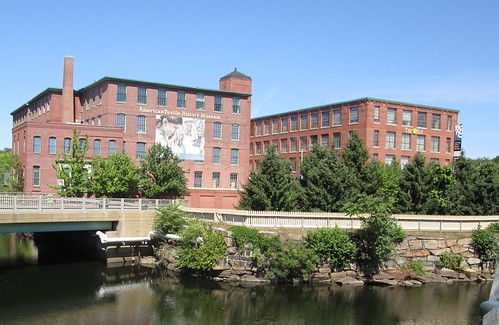American Textile History Museum to Close – Temporarily?

The Lowell Sun reported yesterday on its website that the American Textile History Museum at Dutton Street in Lowell will close “temporarily” on January 1, 2016 due to “ongoing serious financial constraints.” As yet, the Museum has nothing about this on its website.
It the ATHM a casualty of Dutton Street? Undoubtedly there are other issues at play here, but the relative isolation of the museum from the rest of downtown Lowell had to have played some part. If one were to look only at a map, the site the museum occupies would seem a prime location. A quarter of a mile walk from the train station, one hundred yards from Western Avenue Studios and its 350 artists, across the street and down two blocks from Lowell National Park Visitor Center and the Quilt Museum, it sounds like a perfect location. But it isn’t. Because unless you get in your car and drive, you really can’t get to the ATHM from any of those places because the whole area is so inhospitable to walking.
For all the talk in the city about economic development, especially in the adjacent Hamilton Canal District, there seems to be no sense of urgency about improving the Dutton Street corridor. Until there is, places like the American Textile History Museum will continue to struggle.
This is disappointing news, and something that we will no doubt hear more about from the museum staff. On Tuesday evening, I was fortunate enough to be able to take my seminar class on Lowell from the UMass Lowell Honors College to the museum for a vist that was informative and enjoyable. The Textile Museum is a first-class operation and an affiliate of the Smithsonian Institution in Washington, D.C., the premier museum of the nation. Its presence also helps Lowell to be known as a museum city, which is a competitive advantage when considering tourism as an important strand in the Lowell economy. Let’s hope for a rebound here.
I think the ATHM, like many museums, has been the victim of the downturn in the economy. Many museums depend more upon donations and endowments, than revenue from entrance fees. Many years ago a friend worked there with the education programs. A state grant that paid for buses for field trips went away; the field trips stopped and there was no need for her. ATHM sold the building and reduced their foot print in the building. The conservation center moved out. Perhaps that wasn’t enough. Lowell NHP focuses more on the social history and ATHM used to focus more on the technology, so they were an excellent pairing. It will be a big loss if there closure is more than temporary.
Dick, thank you for your interest in and advocacy for ATHM and Lowell’s cultural community. Accessibility to the Museum’s Dutton Street location has certainly contributed to the challenges of getting people through the door. By the way, the website is updated with the information about the temporary closure of the exhibits. There was an issue with the site’s content management system, so the updates didn’t appear until this morning.
With the HCD gaining steam thousands of potential new cars will descend into DTL everyday. The new garage will attract more people to choose driving over bus ,rail, bike, or walking options making travel in Lowell unbearable.
Or maybe not. With Uber becoming ubiquitous and self-driving cars on the horizon(5 years?) will people even own cars in the near future? If people don’t own cars they won’t need to house them in garages or in driveways. All the wasted land we’ve set aside for housing cars could be developed.
Because inner Lowell was built pre WWII reconnecting the neighborhoods to DTL won’t be that difficult. A walkable/bike friendly inner Lowell would reduce demand for Uber and self self-driving cars as well. Quality of life here would sky rocket.
Why then are we building a garage in the HCD?
Why then do we want a new Rourke bridge?
Why not build an elementary school in the Hamilton canal district instead of a garage? Wouldn’t that be more utopian, like the park?